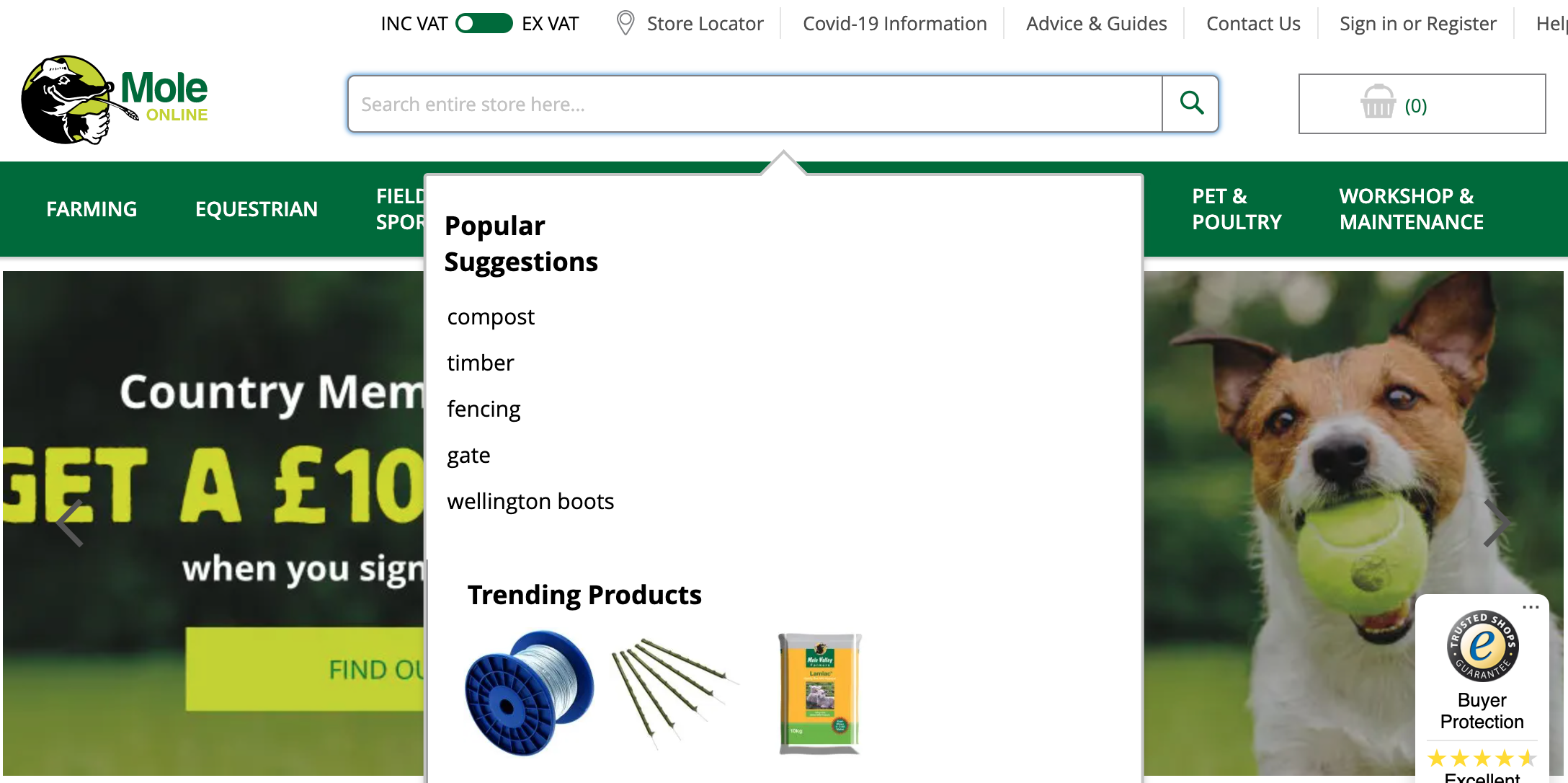Blog
Ecommerce Search Best Practices: 6 Essential Strategies for Optimizing Your Site’s Search Functionality
Imagine the impact on your online business when every search on your website leads to a satisfying customer experience and, ultimately, a conversion. That’s the power of optimizing your ecommerce site search.
Users who actively search are often your most valuable customers, as they tend to have higher average order values, conversion rates, and per-session values. This is why enhancing your ecommerce search with best practices isn’t just a nice-to-have; it’s a critical strategy for taking advantage on significant business opportunities.
Let’s dive into six actionable steps that can transform your ecommerce search, enhancing user experience and boosting conversion rates in a meaningful way.
1. Advanced type-ahead and autocompletes functions
The moment a customer starts interacting with your search bar is your opportunity to guide them towards the perfect product. Consider our client, Mole Valley Farmers. As soon as you activate the search bar, your journey toward product discovery begins. We display trending products, popular suggestions, and for returning visitors, recent searches.
This approach is not just about convenience; it’s about creating a personalized shopping experience that aligns with search UX best practices. Ecommerce search autocomplete feature takes this a step further, using each keystroke to refine product suggestions, making them more relevant and significantly boosting conversion rates.

Effective autocomplete functionality in the search bar is more than just a convenience; it’s a powerful tool for driving sales and customer satisfaction. By actively matching keywords with products in your inventory, we ensure that these suggestions are not only visible but also highly relevant to the customer’s search intent. This strategy aligns perfectly with search best practices, as statistics show users engaging with search suggestions are more likely to convert. Particularly, those who click on product images presented in the autocomplete suggestions experience significantly higher conversion rates.
2. Embracing synonyms and regional variations in site search
Understanding and using synonyms and regional language variations are critical for a seamless site search experience. This approach is particularly vital for global businesses or those serving diverse regions.
For instance, a UK-based jewelry store might use ‘hairband’ as a search term, but neglecting ‘headband’ could result in missed opportunities and zero search results for certain customers. It’s all about refining your search data and enhancing the search experience to prevent potential customers from turning to competitors. Ecommerce search synonyms are a powerful tool in this regard, ensuring a comprehensive and inclusive search functionality.
By enriching your site search with a variety of synonyms and regional terms, you’re not just improving user experience but also casting a wider net to capture a diverse customer base. This approach is particularly effective in avoiding the dreaded ‘zero results’ page, which can quickly lead users to abandon your site in favor of a competitor’s. A robust synonyms database can be a game-changer in this aspect, keeping potential customers engaged and navigating within your site.
3. Leveraging keyword search terms for conversion
Delving into how people search on your site can reveal a wealth of information about their preferences and buying intent. The language and keywords used in site searches often mirror those used in search engines like Google. For instance, customers may search for specific attributes like ‘silver laptops’ or ‘pink netbooks’ instead of generic brand names. Understanding these conversational keyword terms is crucial for directing your SEO and PPC efforts effectively.
This knowledge allows you to strategically invest in creating content or collections around these specific search terms, thereby attracting a targeted audience more likely to convert. Adding these insights into your overall SEO strategy can significantly enhance your site’s visibility on search engines, drawing in users who are already demonstrating an interest in your products based on their on-site search behaviors. In essence, you are aligning your eCommerce search terms with broader search engine optimization synonyms to capture and convert a larger segment of online searchers.
4. Strategies to avoid zero results in search
Avoiding zero search results is a crucial aspect of maintaining user engagement and reducing bounce rates. We can learn from brands like Missy Empire, which have effectively personalized the language used in their search results to better resonate with their audience. However, the goal extends beyond just avoiding a zero-results page. It’s about strategically re-merchandising to showcase popular products and searches, re-engaging users, and guiding them towards items they might be interested in.

This approach is about turning a potential negative experience into a positive one. By presenting users with alternatives and popular choices, you not only keep them engaged but also introduce them to products they might not have initially considered.
This strategy is an excellent example of effective search UI design, where the user’s journey doesn’t end with a fruitless search, but rather leads them to discover other relevant products. Implementing a smart no-results strategy, like showcasing popular products or personalized recommendations, can significantly reduce bounce rates and enhance the overall search UX.
5. Natural language processing for enhanced search accuracy
Integrating Natural Language Processing (NLP) into your search functionality can revolutionize how users interact with your site. NLP allows for more complex queries, like “men’s sneakers under $100,” by understanding and processing user intent. This advanced search capability, akin to what we see with voice assistants like Alexa and Siri, is becoming increasingly important in eCommerce.
Our client Cox & Cox, for instance, uses a microphone option in their search bar, leveraging ecommerce search NLP capabilities to accurately interpret and respond to customer queries. This level of sophistication in understanding search queries is a hallmark of cutting-edge semantic search.

6. Search Filters
Revolutionizing search UX further, AI-powered dynamic filters represent the next level of faceted search navigation. Unlike traditional dropdown menus, these AI-driven filters adapt and evolve based on user behavior, creating the most relevant and personalized search experience. For instance, in ecommerce faceted search, customers can intuitively refine their search criteria alongside the search bar, without disruptive pop-ups or dropdowns obscuring the product listings. This smart filtering not only enhances the search process but also provides valuable insights into customer preferences and behaviors.
Conclusion
Implementing these six ecommerce search best practices can markedly improve your site’s search functionality, leading to a better customer experience and higher conversion rates. Remember, a well-optimized search function is more than just a feature; it’s a significant driver of user engagement, sales, and valuable customer insights.
Whether it’s through advanced autocomplete search bars, intelligent use of ecommerce search synonyms, or leveraging natural language processing search techniques, each of these strategies plays a crucial role in optimizing your ecommerce site for both user experience and business success.


